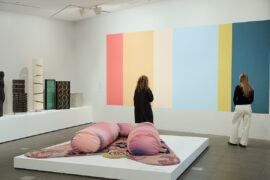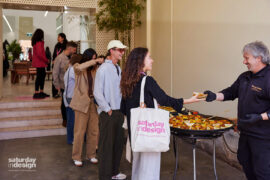The country’s best chefs are teaming up with top hoteliers to offer travellers and locals a unique in-hotel dining experience. It’s the ultimate ‘staycation’ – with all the trimmings. We unpack the movement.
September 25th, 2018
Hotel dining isn’t usually something we seek out. In fact, buffet breakfasts aside, we never would have considered eating at a hotel restaurant. That is, until recently.
When visiting a new city, we inherently feel like foreigners, and most of us want to get out and explore the neighbourhood, discover something new and eat where the locals eat. But lately there has been a shift in the design direction of hotel precincts which not only keep their guests close, but also offer a dining ‘staycation’ for locals, too. This new approach to hotel amenity offers much more than an impressive lobby, a nice bathroom, and club sandwiches on the room service menu. Some of our cities’ best chefs are opening establishments in boutique hotels, bringing neighbourhood eateries to locals and travellers alike.
Scott Pickett and Mat Lindsay aren’t two names you’d usually associate with hotel restaurants. Both are celebrated chefs in their respective cities (Melbourne and Sydney), both with iconic restaurants to their names – Pickett with the Estelle Bistro, ESP and St Crispin, and Lindsay with Ester. Both have also recently opened new restaurants, which happen to be in hotels.
“Buildings need energy, people, movement, noise, that was the main reason for having a restaurant as a significant element of the hotel,” says Darren Rubenstein of United Places in Melbourne. In June, property developer Rubenstein, with his father-in-law Richard Roberts, opened their first hotel – a 12-suite boutique hotel opposite Melbourne’s Royal Botanic Gardens in South Yarra.

Bathroom in the Matilda restaurant at United Places, designed by Projects of Imagination. Photo by Tim Grey.
United Places has been designed by Carr, with spacious one- and two-bedroom luxury apartment-style suites. Interior features include rendered walls, timber floors and opulent details like glass pod bathrooms, and velvet curtains that open onto leafy garden vistas. Downstairs, Pickett’s restaurant, Matilda, is an 80-seater brasserie designed by Projects of Imagination, with a menu that focuses on wood-fired cooking.
“Whether you are travelling for business or leisure, when you get back into your room, you don’t want to rush out. You want things to feel comfortable and convenient, you want to be spoilt,” says Rubenstein. “Rarely is there an opportunity to have a nice meal.” On the ground floor of United Places, Pickett has opened his first southside restaurant, creating a space Rubenstein describes as the entry point to the hotel, where guests can get a taste of what the hotel is about.

Matilda has been designed with attention to detail, including a careful selection of tableware. Photo by Tim Grey.
“Matilda is very earthy, very warm, very homey, very authentic, and that translates back into what the hotel is.” There’s a lot of wood and natural tones, blackwood tables, clay plates by Andre Davidoff, hand-blown glass pieces by Mark Douglas, and life-sized images by Bill Henson of the Botanical Gardens.
“There is a very natural synergy between us and the hotel,” says Pickett. “It’s a place that sort-of encapsulates the local area, from the rooms to the restaurant.”
As well as servicing the eatery and basement bar, Matilda is providing room service or “glamour comfort food” such as chicken cooked over coals with a side salad, or a piece of grass-fed beef with a peppercorn sauce. The restaurant will also be making the turndown treats and mini bar items like housemade gin and mixers, which can be ordered from the on-call butler.
At Paramount House Hotel in Sydney, the space transitions from a slick coffee shop (Paramount Coffee Project) into a communal hotel lobby within a couple of steps. In April, Russell Beard, Ping Jin Ng and Mark Dundon (of Reuben Hills, Paramount Coffee Project, Seven Seeds and Bondi Hall between them) opened their first hotel in the backstreets of Surry Hills. The 29-room site has been designed by Breathe Architecture with a mix of concrete, terrazzo, timber and greenery across various rooms from the Everyday to the Mack Daddy. Some with colourful shag rugs by Jardan and timber baths by Wood and Water, all with access to the rooftop Recreation Club, the basement Golden Age Cinema, and Mat Lindsay’s new restaurant, Poly.
“We wanted to have a space where you could get a great coffee in your room or downstairs in the café. Where you could have a break, a snack and glass of wine at night, and also where you could hang out in the lobby and feel like you were part of a community,” says Beard.
In the bottom corner of the complex on Commonwealth Street, Lindsay has opened Poly, a dark, moody bar (previously a furniture showroom) with Ester sommelier Julian Dromgool. Also an 80-seater space, Poly has been designed by architect, Anthony Gill, who worked on Ester and other local venues Vini and Berta.
Lindsay says Poly is more a wine bar than Ester, like an izakaya (but not Japanese), serving lots of snacky things you can eat with your hands, a larger wine list and some cocktails. “You’ll see a little DNA of Ester, but we’re quite conscious of keeping Poly its own thing. We want it to be more casual, a nice, easy neighbourhood place that people can drop into, or come down from the hotel.” Like Matilda, Poly will be providing special in-room dining for hotel guests.
What is so defining about these resident eateries is that they are restaurants in the hotel, but are not hotel restaurants (in the way we have previously known them). Both Poly and Matilda are standalone experiences – available to non-hotel diners – that create energy and atmosphere, complementing and enhancing the offer at the hotel. By bringing in these chefs, they are creating places that locals want to dine in, as well.
Whether you’re eating in the restaurant or putting your feet up and dialling down for room service, recruiting the city’s best chefs is part of the ultimate vision to host, indulge and make guests feel even at home at these hotels. Even if it’s a very fancy version of home.
This article originally appeared in issue #74 of Indesign Magazine, the ‘Design Relish’ issue, which explores the new age of hospitality design.
–
Sign up for our newsletter and get a weekly dose of inspiring stories on design.
INDESIGN is on instagram
Follow @indesignlive
A searchable and comprehensive guide for specifying leading products and their suppliers
Keep up to date with the latest and greatest from our industry BFF's!

The undeniable thread connecting Herman Miller and Knoll’s design legacies across the decades now finds its profound physical embodiment at MillerKnoll’s new Design Yard Archives.

London-based design duo Raw Edges have joined forces with Established & Sons and Tongue & Groove to introduce Wall to Wall – a hand-stained, “living collection” that transforms parquet flooring into a canvas of colour, pattern, and possibility.

With standout presentations from the likes of Gaggenau, Jardan and Living Edge, here’s a considered first look at a handful of exhibitors shaping the tone of Saturday Indesign 2025.

Unlock your all-access pass to Melbourne’s most exciting day in design.
The internet never sleeps! Here's the stuff you might have missed

NGV exhibition ‘Making Good: Redesigning the Everyday’ is open – and be prepared to be amazed and delighted by great creative design.

Collingwood pulsed with energy at Saturday Indesign 2025, where talks, launches and activations spilled from showrooms into the streets.